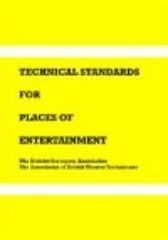Synopsis
Technical Standards for Places of Entertainment
Published by Entertainment Technology
Local licensing authorities impose technical requirements to ensure the safety of the public, staff and performers in places of entertainment such as theatres, cinemas, discotheques, night-clubs and concert halls, and an overhaul of these requirements has been long overdue
Technical regulations have in the past led to a number of problems, including regulations that were too specific, varied expertise and resources available to individual licensing authorities, local variations, regulations that were often too narrowly concerned with the safety of the public and ignored risks to staff, and regulations that were based upon a mandatory approach that frequently ignored the concept of assessment of risk
The District Surveyors Association (DSA) and the Association of British Theatre Technicians (ABTT) recognised these problems and five years ago set up a Working Party to seek a resolution
Technical Standards is the result
The book was produced in partnership involving both the industry and local authorities and was widely circulated in draft for pre-publication comment
All comments received were carefully considered and appropriate revisions to the draft were made A number of new features are intended to address previous problems
Functional requirements are supported by technical guidance
They incorporate Model Technical Regulations that detail the straightforward standards that should apply to any premises used for entertainment
This will help to ensure an appropriate and consistent national standard for all entertainment premises
The Model Technical Regulations are part of the new Model National Standard Conditions for the licensing of entertainment premises. The Standards deal with the physical requirements for building (or converting), equipping and maintaining any entertainment premises through a series of related discussions on subjects such as Site, Means of Escape, Building Services, Stage Engineering, Fire and Emergency Systems, Communications and Signs
The Commentaries consider problems particular to entertainment premises and introduce the Model Technical Regulations intended for the use of local authorities
Each Model Technical Regulation is accompanied by Recommendations, which suggest ways that its functional requirement may be met
Advice is offered on safe standards and good practice for all types of entertainment premises. The problems of smaller premises and conversions of existing premises for use for entertainment are fully considered
The Standards are also concerned with the safety and well-being of all users of entertainment premises. The Working Party remains in existence as a Standing Committee. Within the book there is an e-mail address whereby those using the document can advise the Committee of difficulties of interpretation, new products and ideas
 $79.99
$79.99